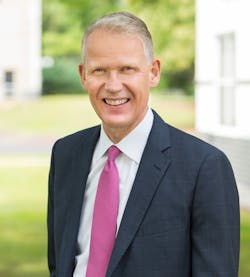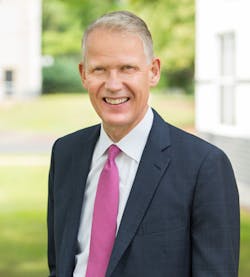Heiner Markhoff: Taking Charge of Suez's New Industrial Juggernaut
By Tom Freyberg
In September SUEZ closed its €3.2 billion acquisition of GE Water. Heading up the new division will be Heiner Markhoff, formerly from GE. We manged to catch him inbetween a busy travel schedule.
The announcement that SUEZ was to buy GE Water in a headline acquisition did not come as a surprise to many. Weeks before the CEO Jean-Louis Chaussade hinted in a financial results meeting that buying GE’s water division would be of interest.
It was at the end of September when the €3.2 billion buy was completed, together with Canadian investment company Caisse de dépôt et placement du Québec. A new business unit – Water Technologies & Solutions (WTS) – has been set up to combine SUEZ’s existing water division and the new GE industrial portfolio.
The task will now be to integrate two sizeable industrial water businesses, including the 7,500 GE employees, around the world. Furthermore, over half of the GE business was made up the chemical company BetzDearborn, acquired in 2002 from Hercules Incorporated.
Furthermore, the WTS business will need to incorporate existing municipal projects inherited from SUEZ’s Degrémont business, while pushing into the industrial markets, particularly in the US – one of its target markets.
The man tasked with such challenges is Heiner Markhoff, the former president and CEO of GE Water. A 23-year veteran within GE, having worked in the power, plastics and automotive divisions of the company, Markhoff will be responsible for leading the business globally.
Water & Wastewater International (WWi): Which sector do you see as having the most growth potential and why for the new Water Technologies & Solutions (WTS) business?
Heiner Markhoff (HM), CEO, Water Technologies & Solutions: With the expanded portfolio of solutions we are better able to meet the needs of all customers. Our broad range of integrated solutions help key customers in a wide range of industries from power generation, oil and gas to food and beverage address their water and process challenges, drive efficiencies and meet regulatory requirements.
WWi: How much are you expected to grow the WTS division? I’ve read figures of a predicted 5 percent growth rate until 2020?
HM: We see good growth potential in our target markets.
WWi: WTS will be primarily focused on the industrial sector yet it will inherit all of GE’s municipal water activities – how will the company balance managing both of these portfolios?
HM: We will manage our portfolio just as we do today, but with added expertise and solutions. We look at our customer base as contributors to the sustainability and responsible management of the water ecosystem. Our portfolio of solutions are flexible to meet both industrial and municipal needs in combatting challenges like water scarcity through reuse as in our Membrane Bioreactors (MBR) or Ozonia and ultraviolet solutions.
WWi: Some water clients do not wish to have projects and services bundled together with in-house kit from the same companies. How will SUEZ face this challenge with the integration?
HM: Our goal is to meet our customers’ needs based on their challenges, timeline and budget. The positive thing about such a broad portfolio is that there doesn’t have to be a one-size-fits-all approach. We can create a package that is unique for each customer.
WWi: GE built up a mixed technology offering, including electrodialysis reversal, membrane bioreactor and zero liquid discharge technologies, before the integration. Does SUEZ intend to compliment this with further additions or acquisitions?
HM: These solutions are integral to the resource revolution by combatting water scarcity via reuse and resource recovery. Ultimately, we look to draw on the best possible portfolio of solutions that can be combined and configured to meet a customer’s budget, delivery timeline, footprint and water quality and availability needs.
WWi: In December the company plans to present its strategy for the industrial water markets. What will shareholders want to hear from this?
HM: I think shareholders want to see plans for sustainable, responsible and profitable growth that is founded in our ability to deliver competitive solutions to our customers, leveraging our broad product, process and digital capabilities.
Tom Freyberg is the chief editor of WWi magazine.
More Water & WasteWater International Archives Issue Articles

